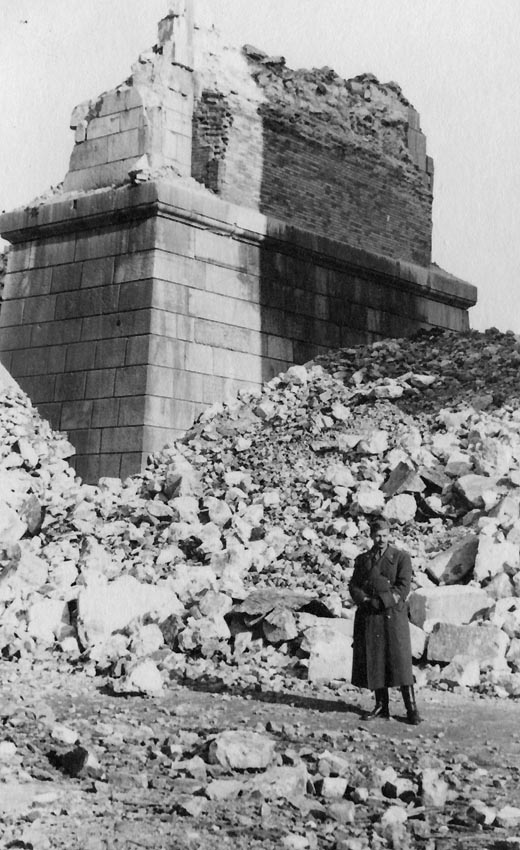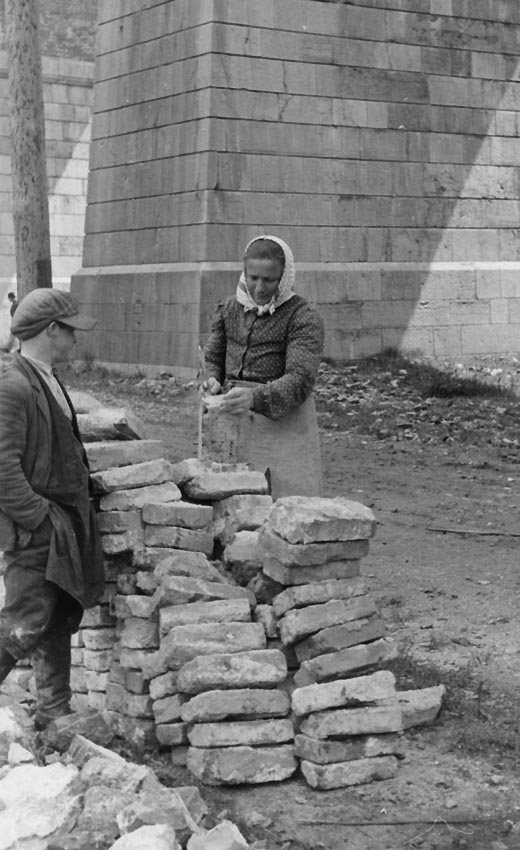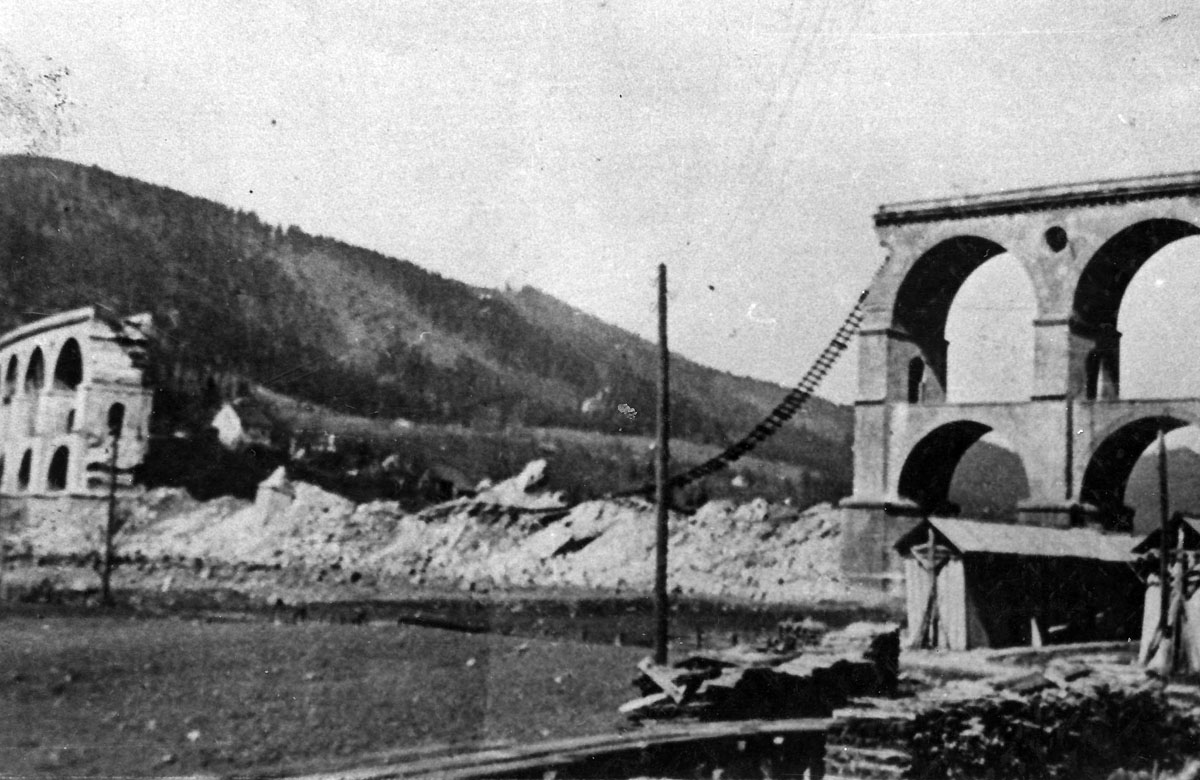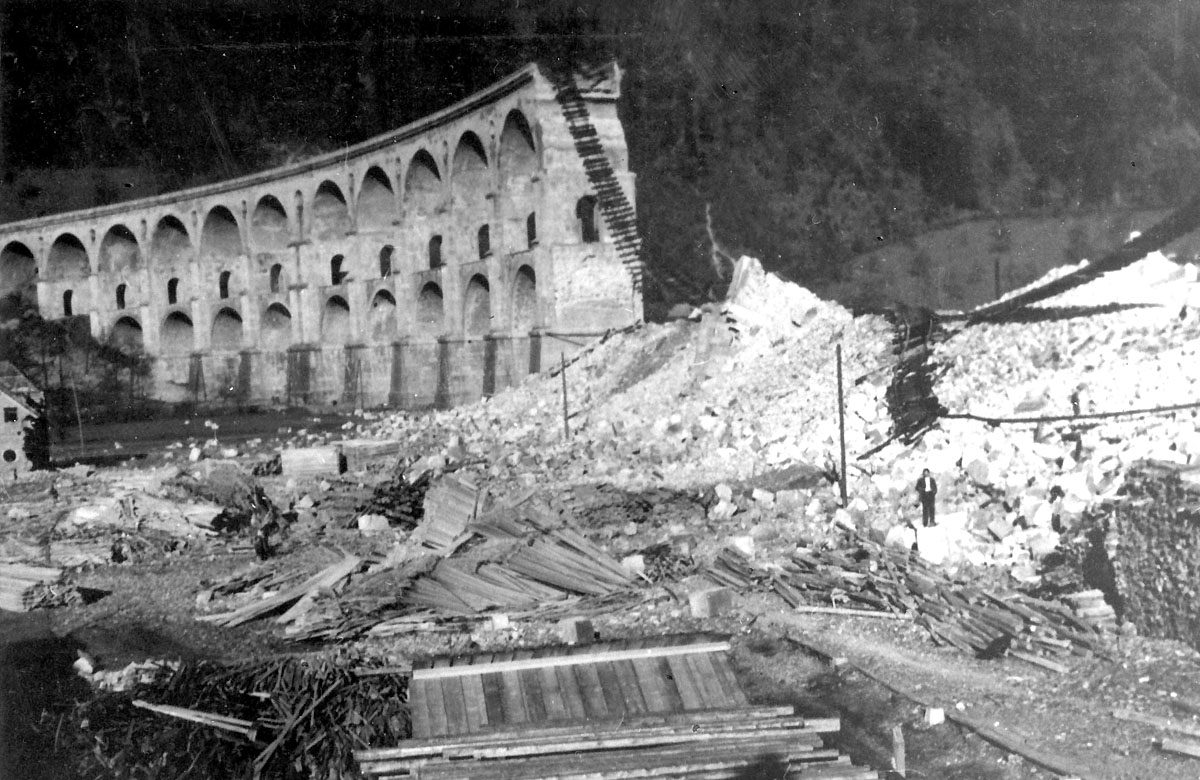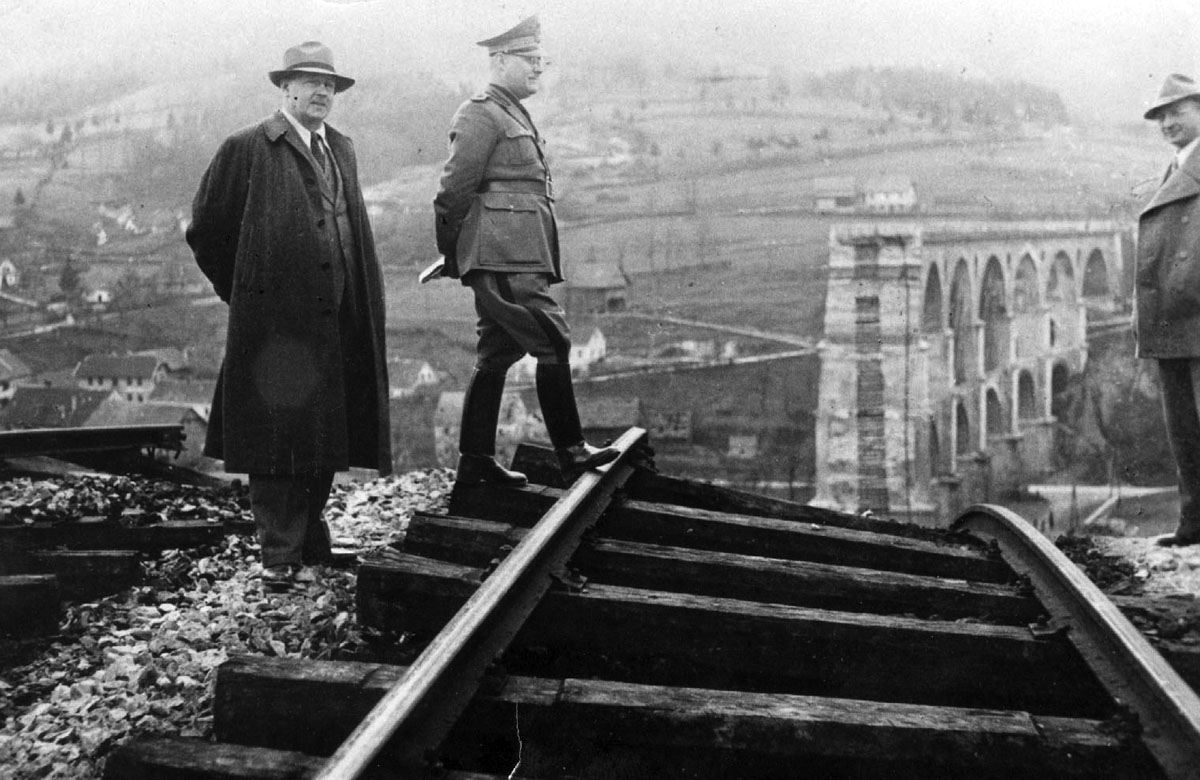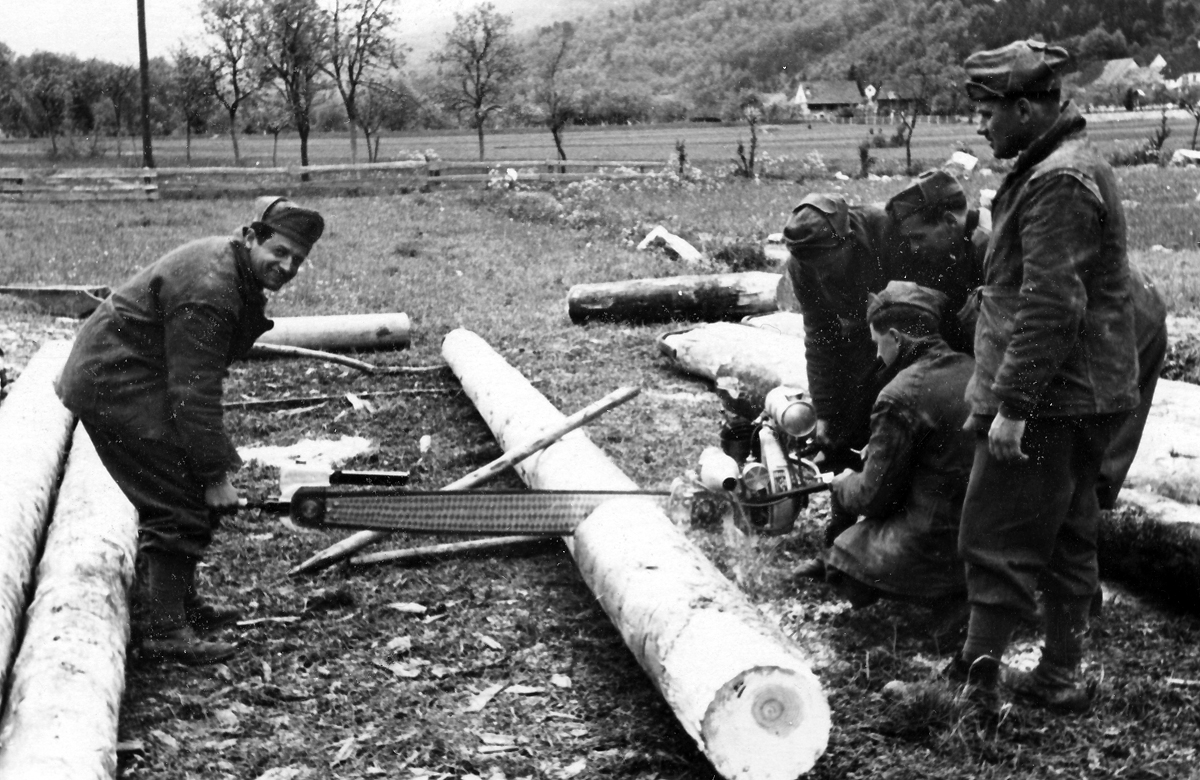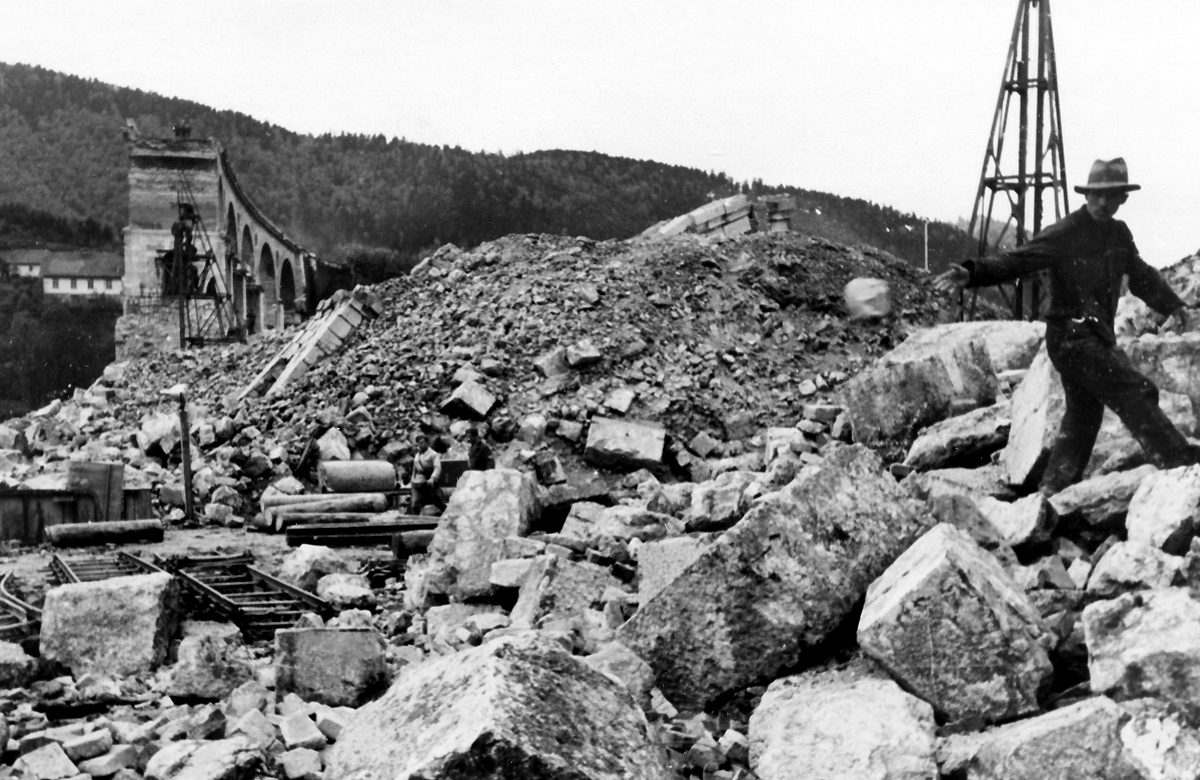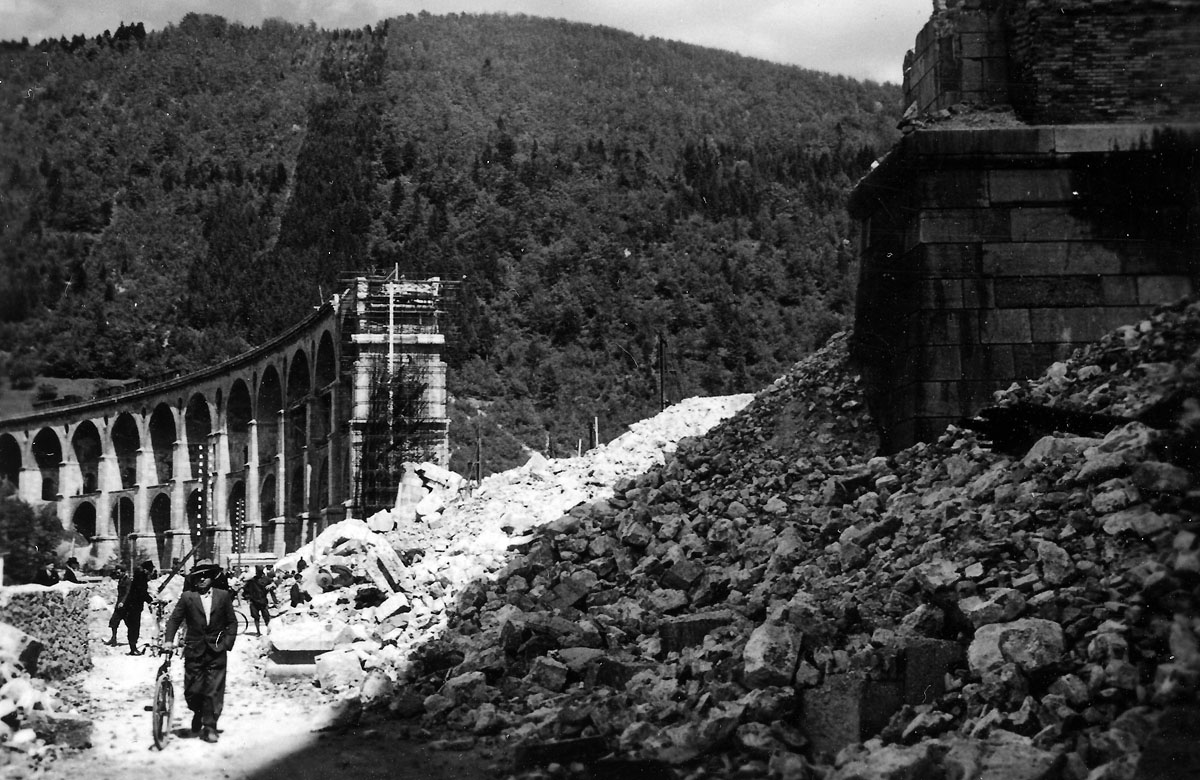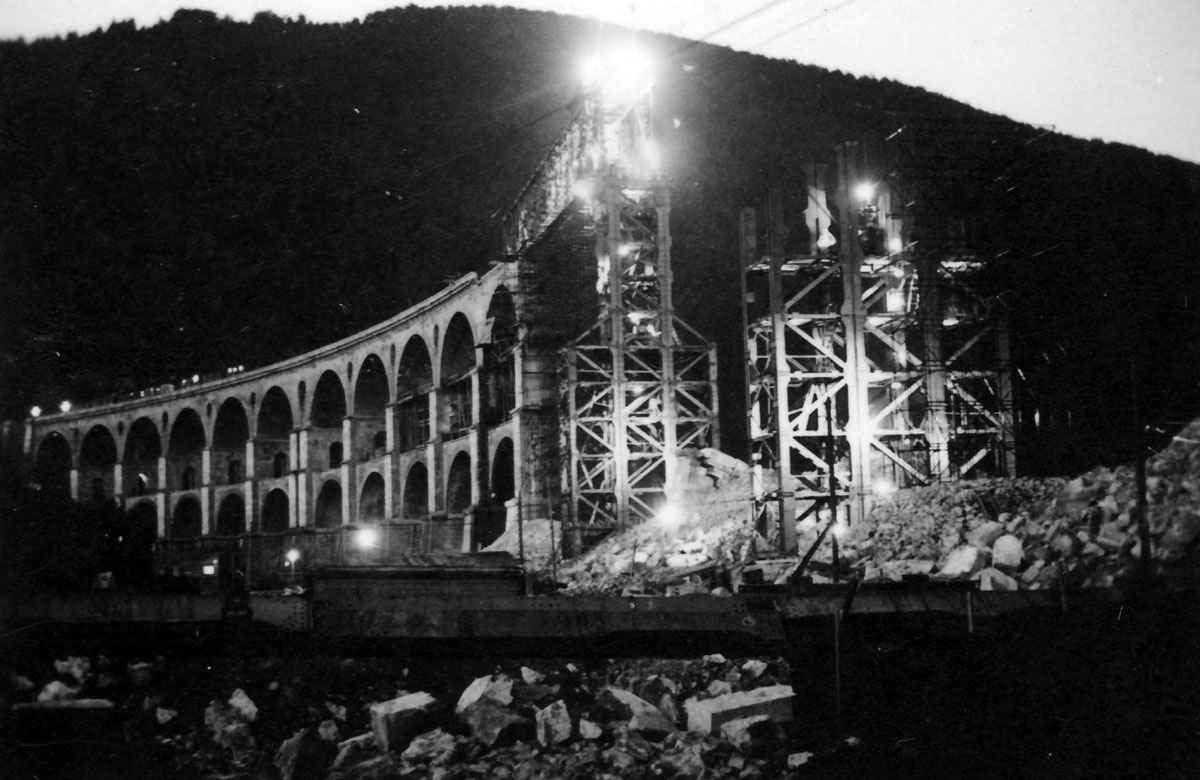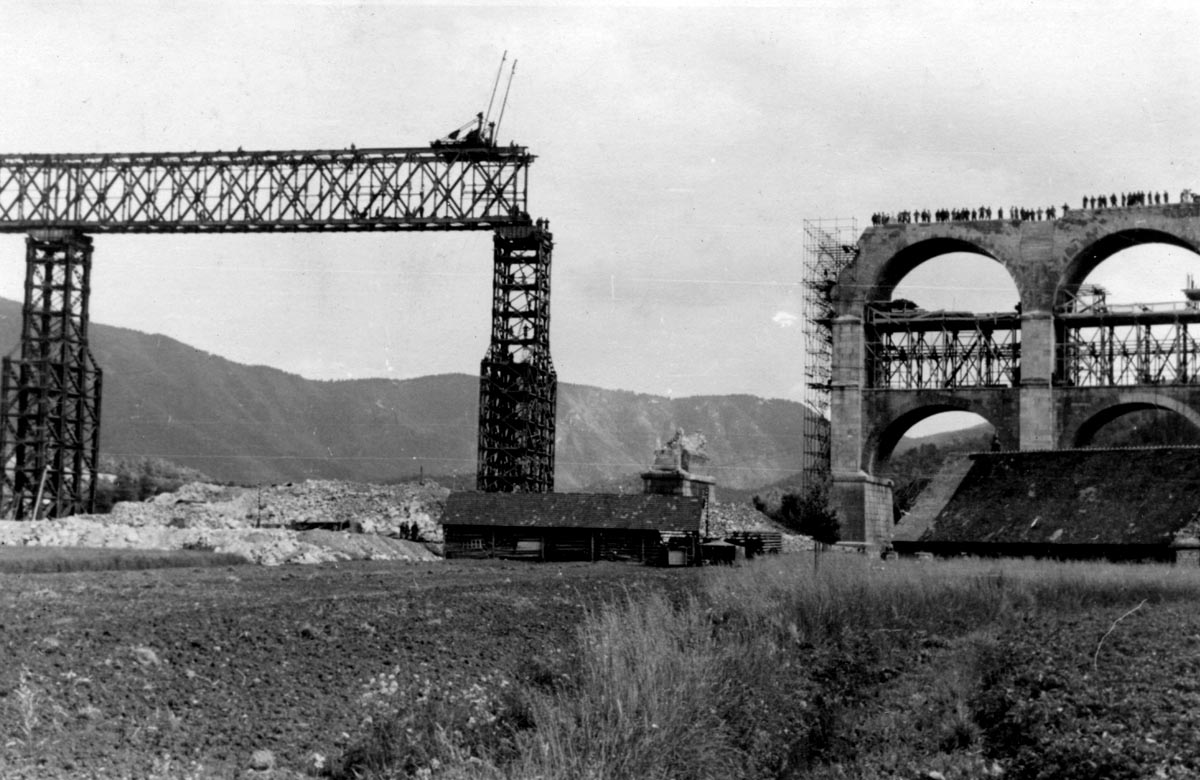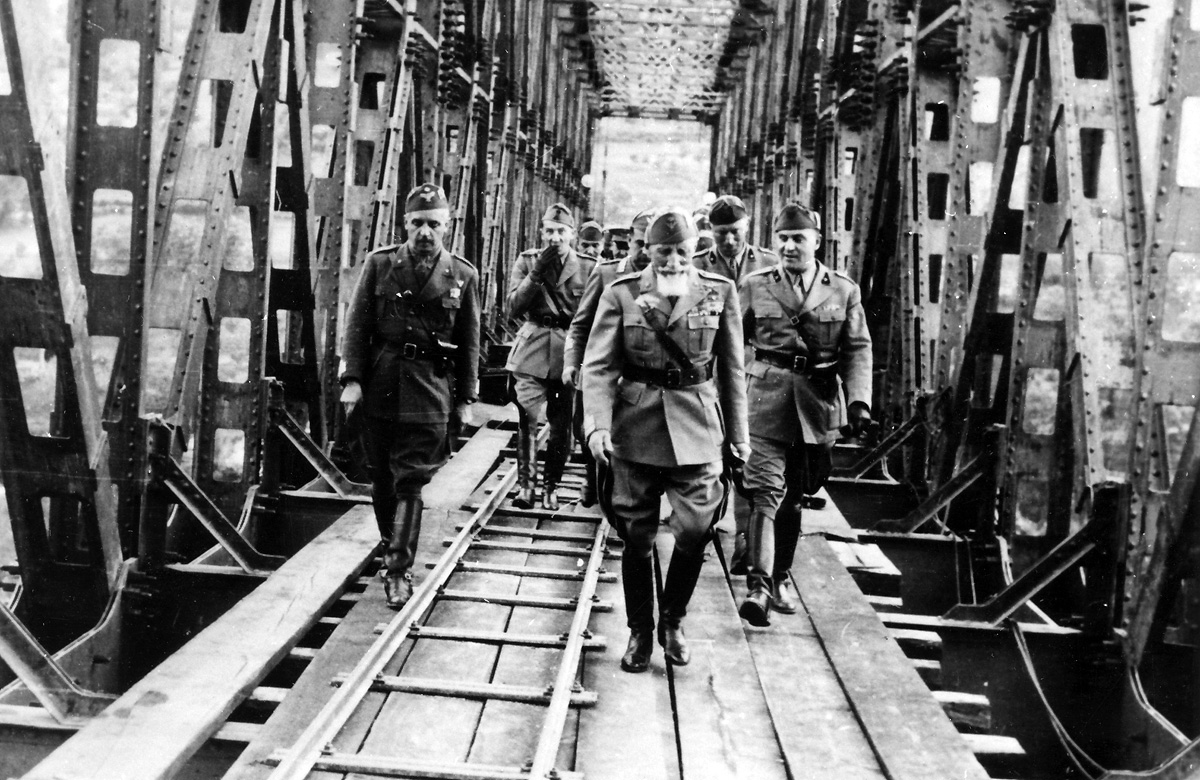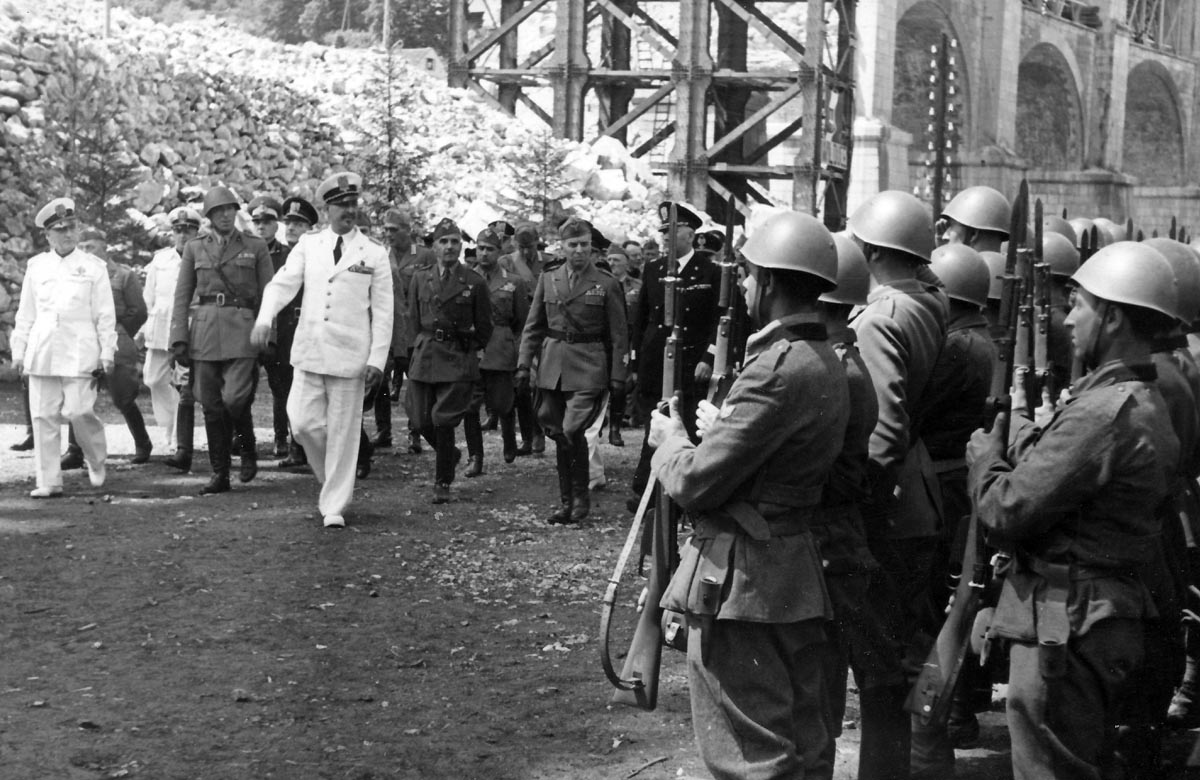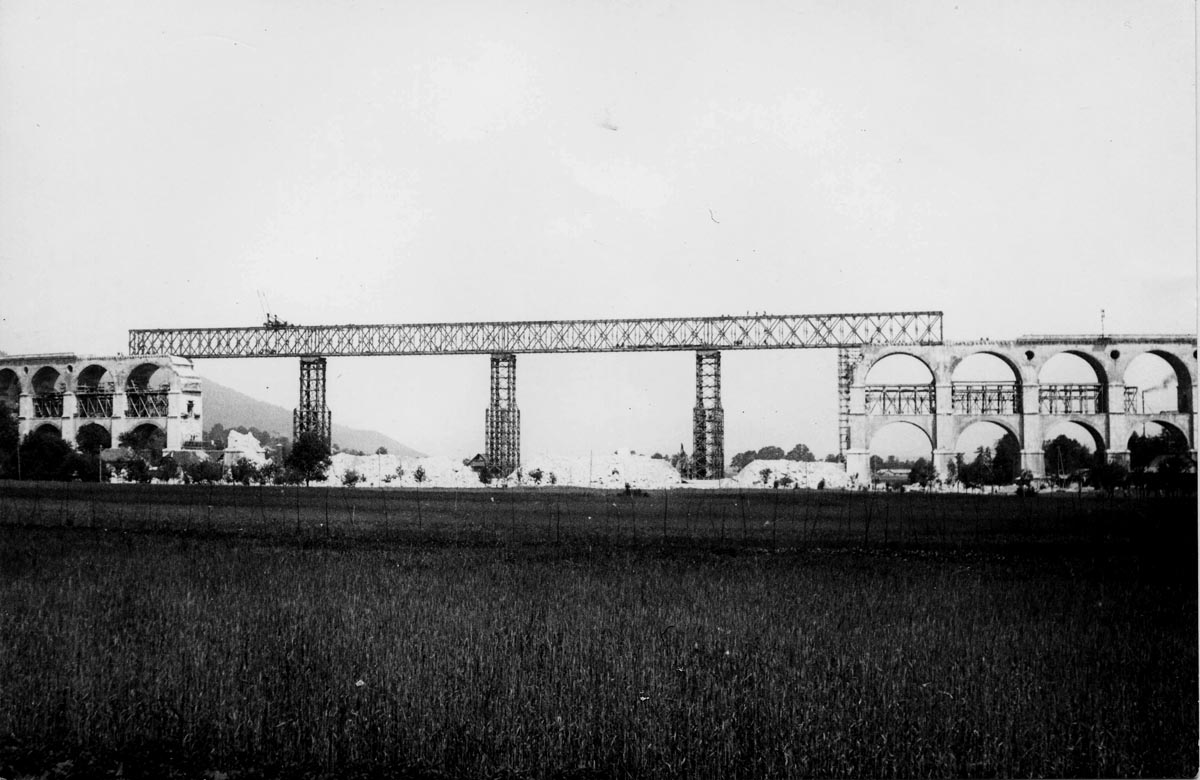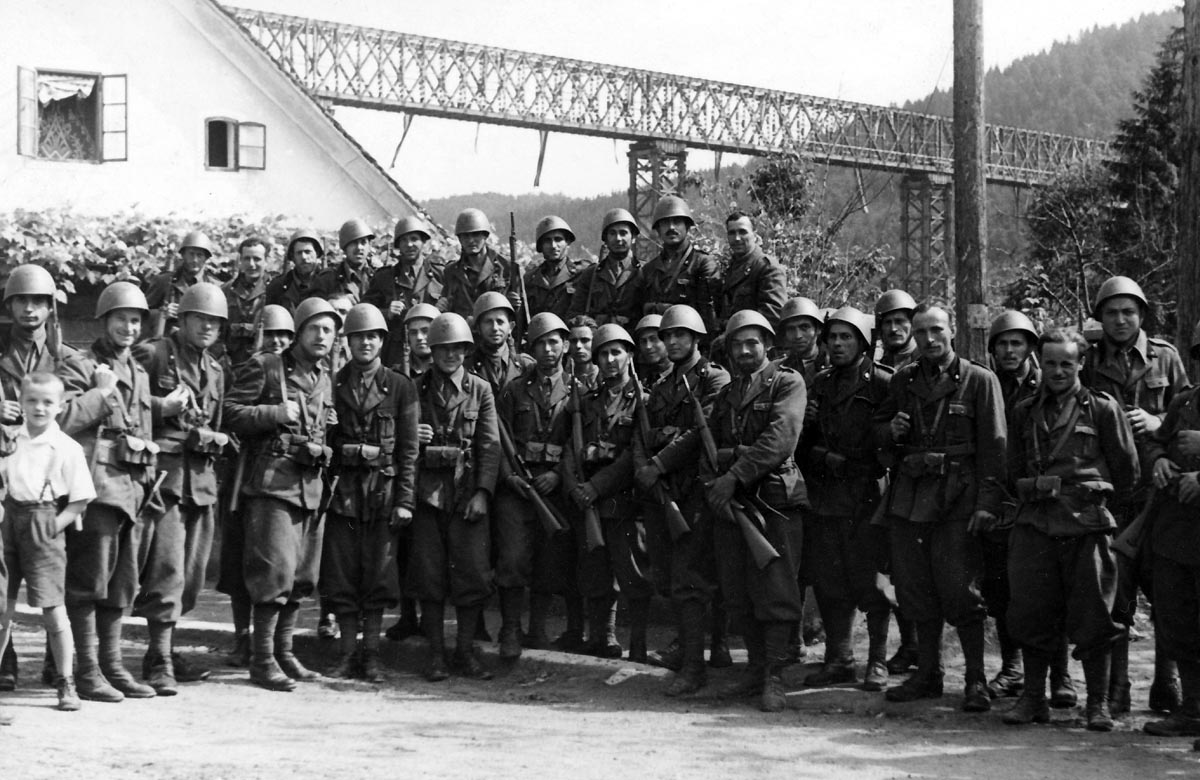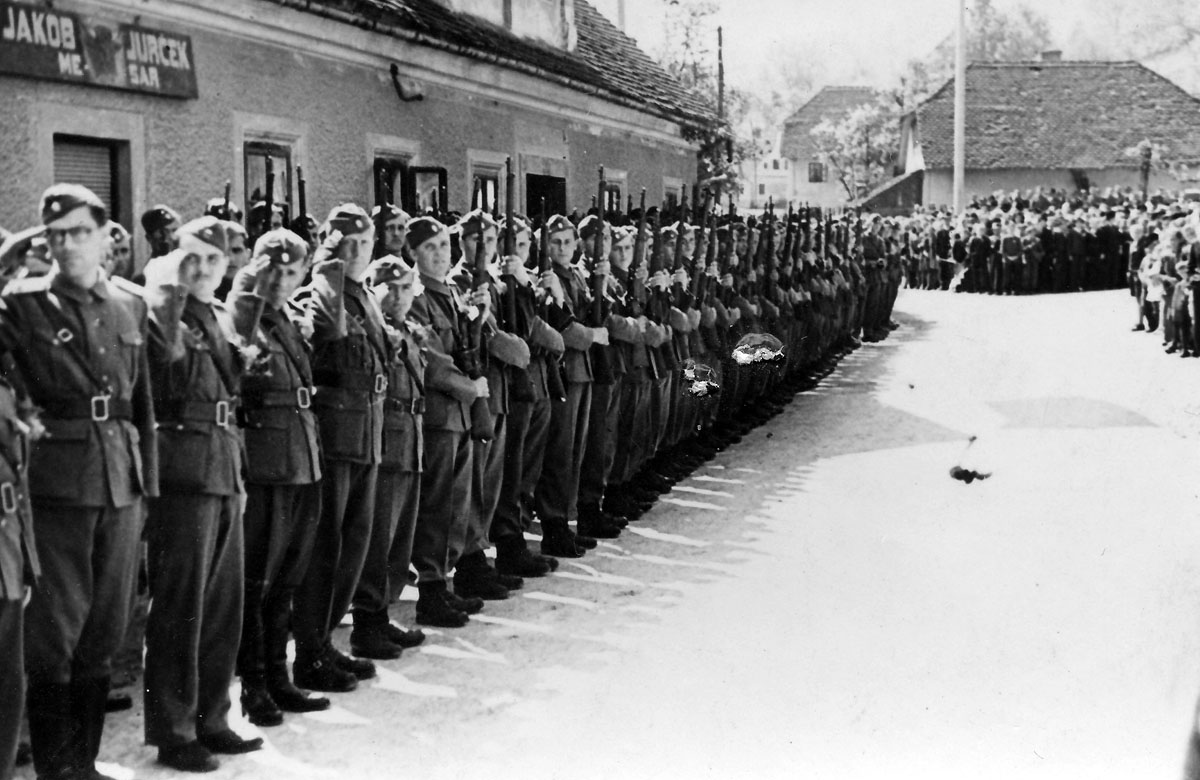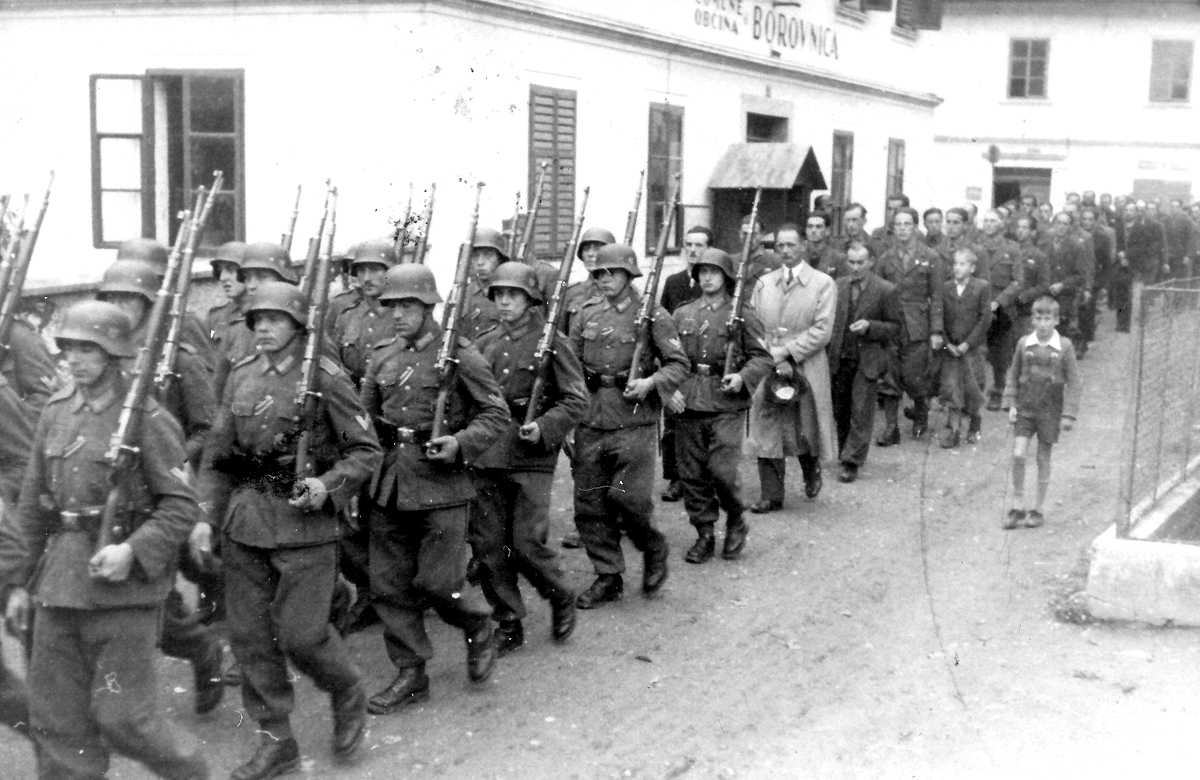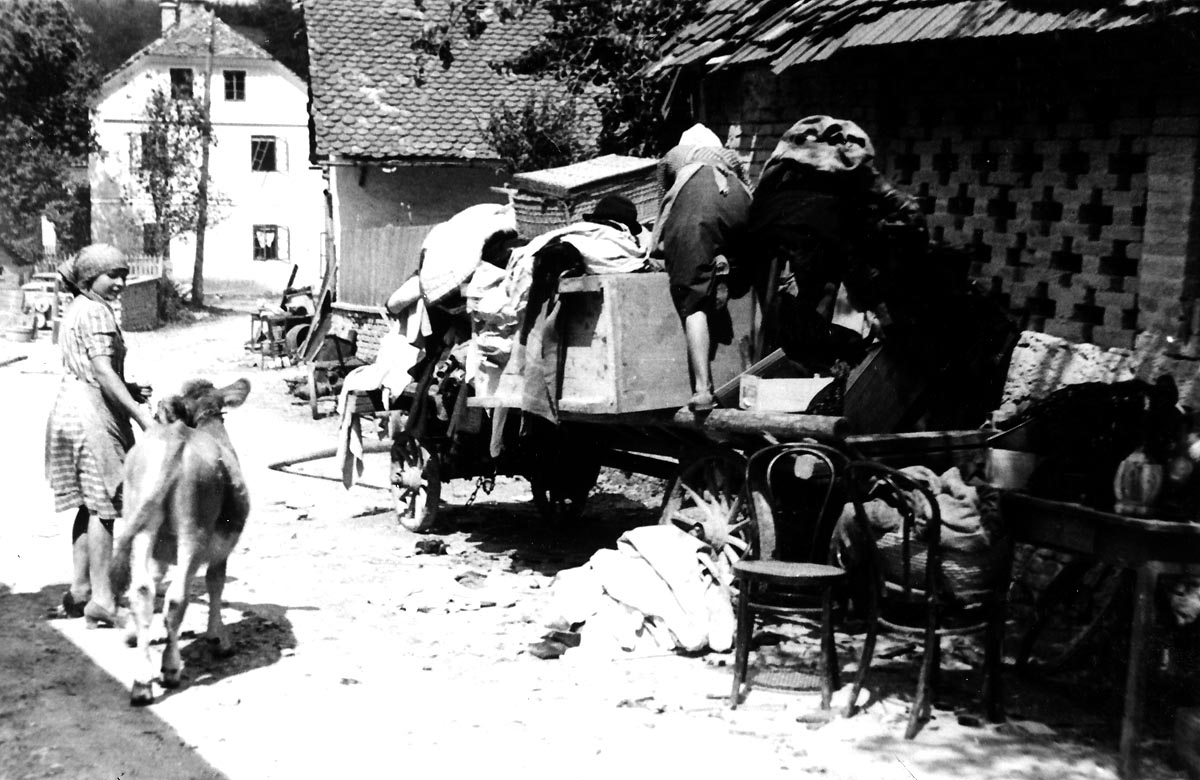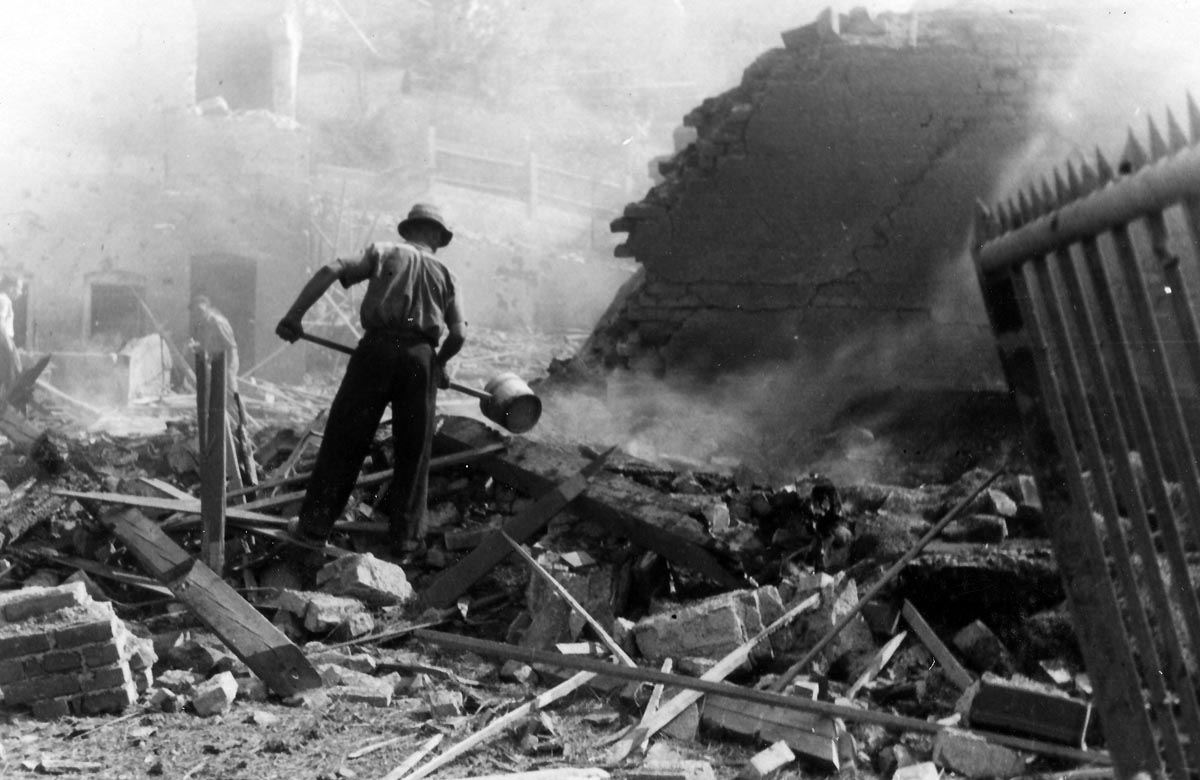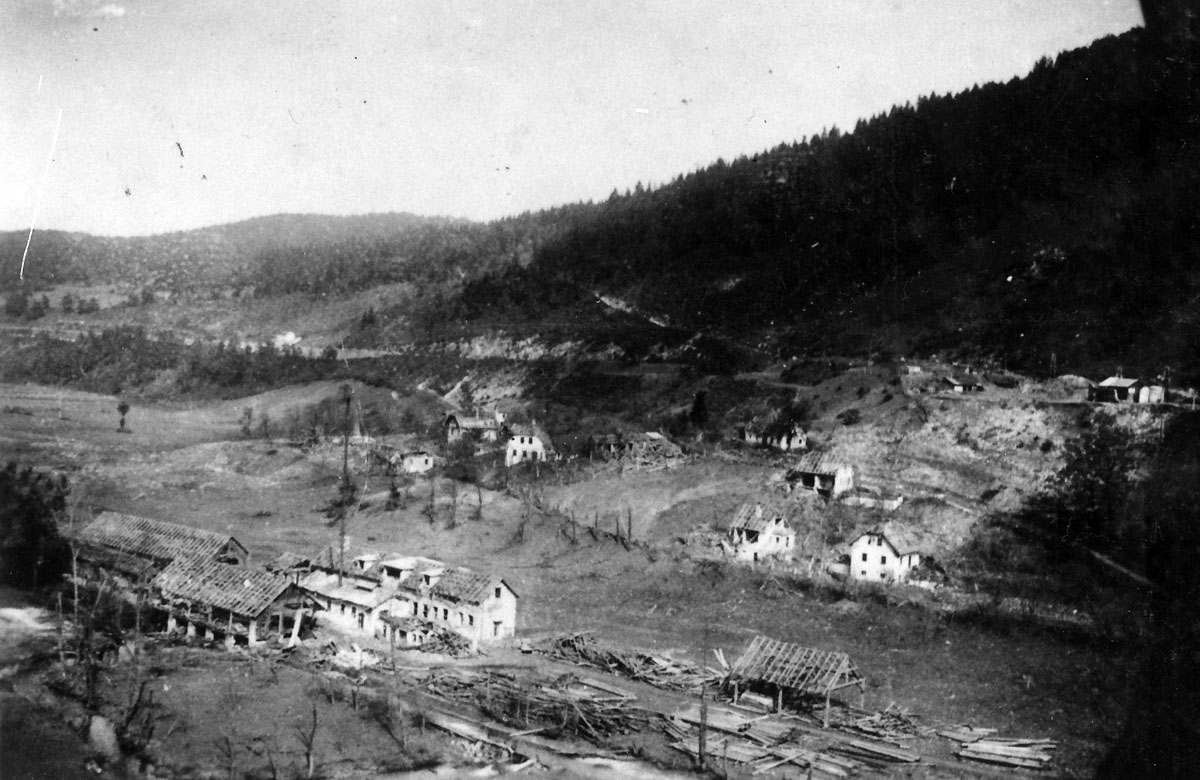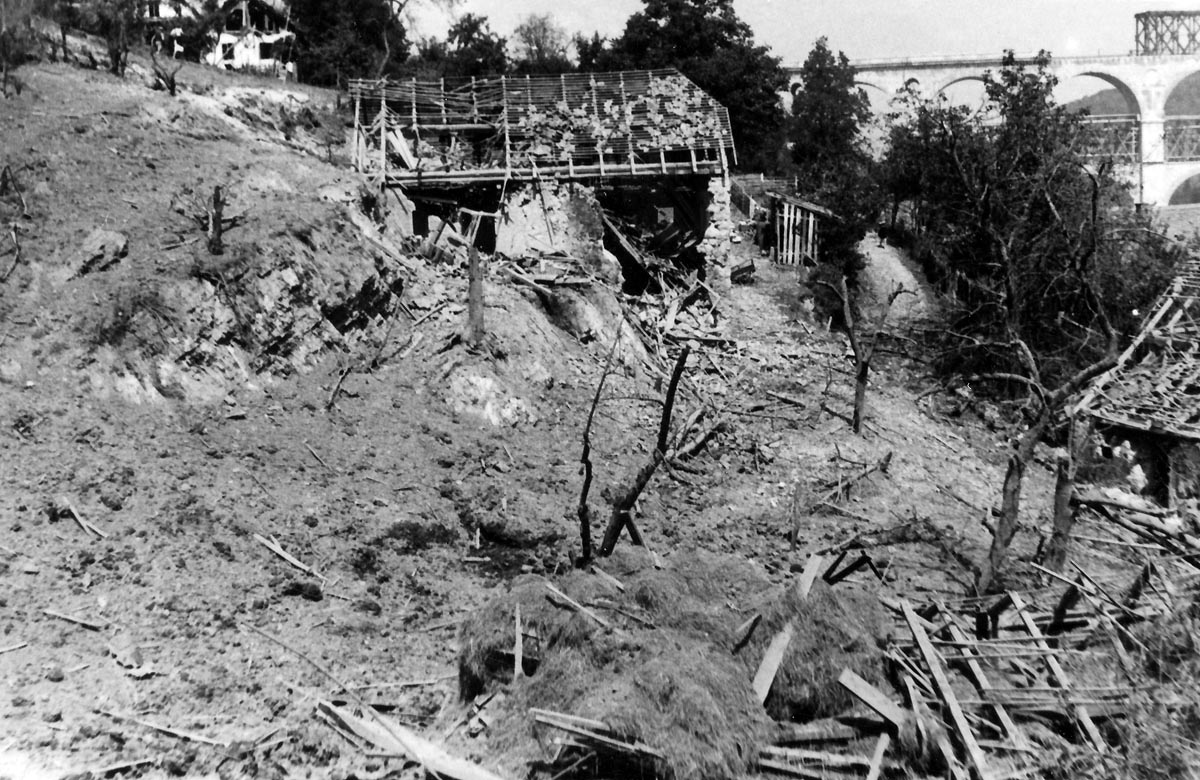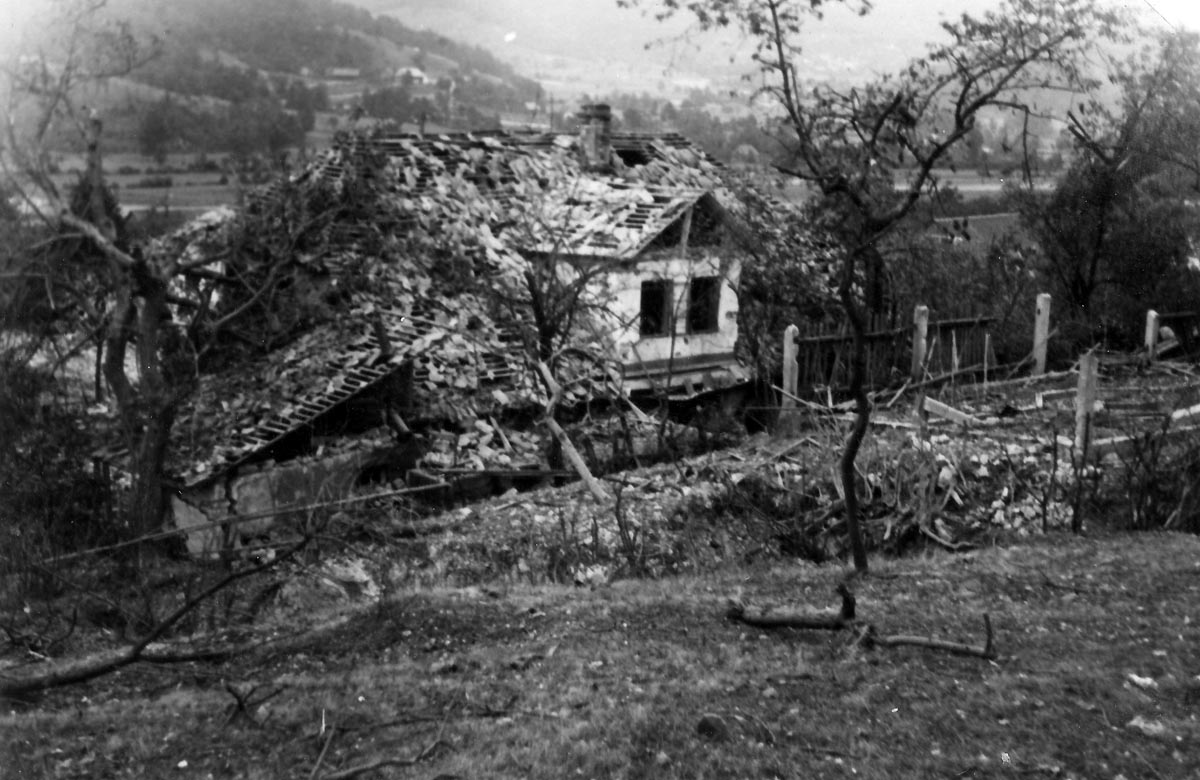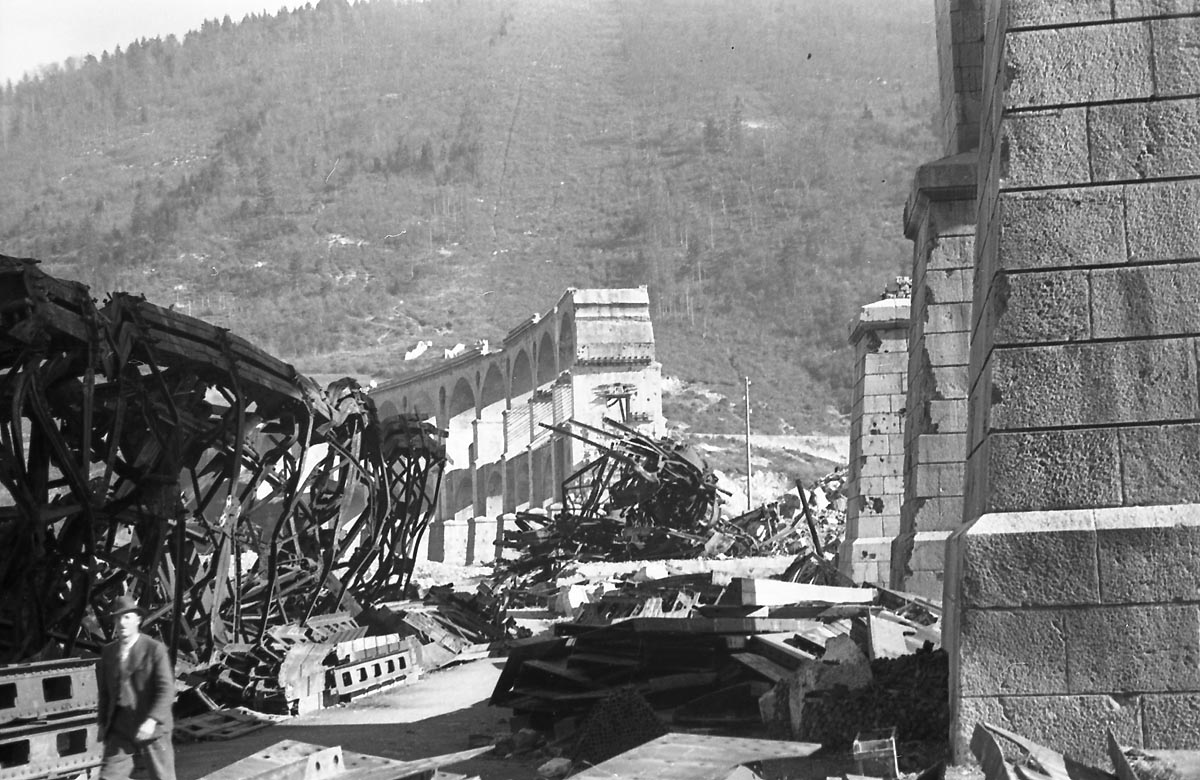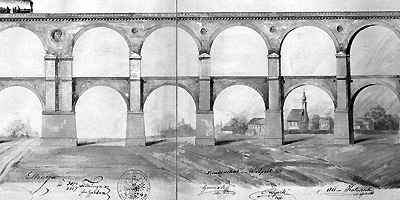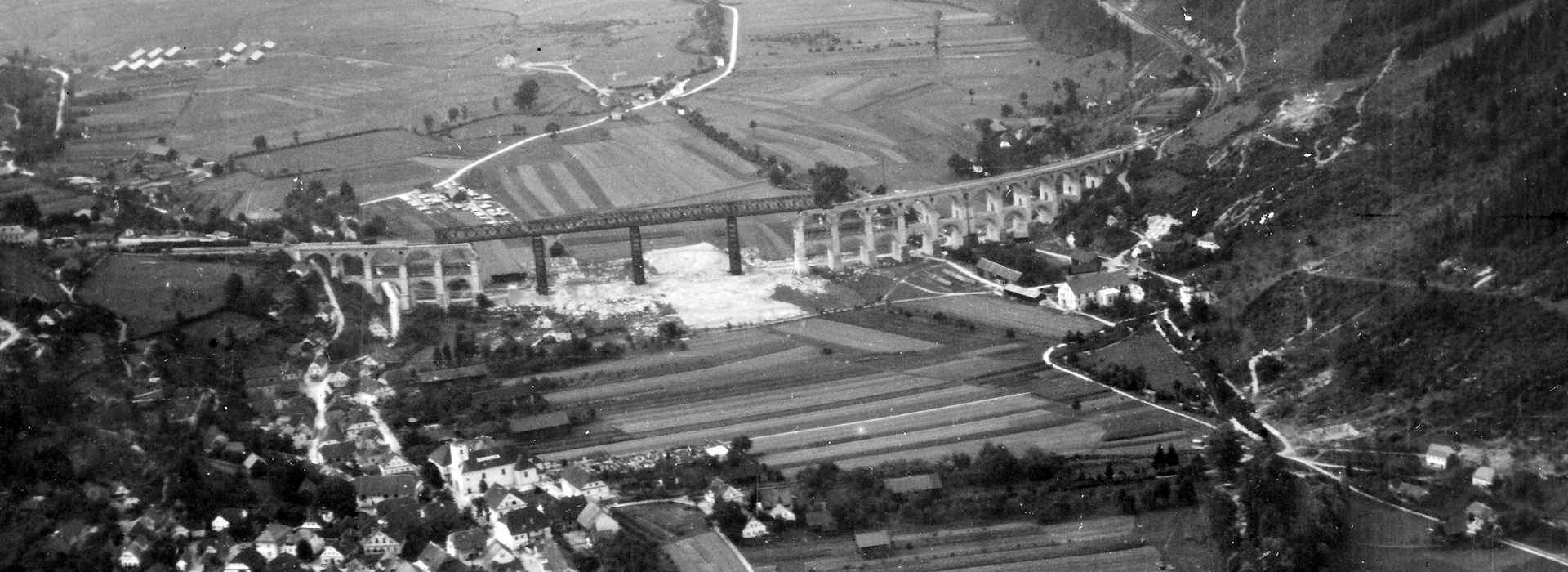
Borovnica railway viaduct 1850 – 1944
10. april 1941
After the First World War, when the state border with Italy came very close to the Viaduct, a permanent fire and watch service was organised at the Borovnica Station. Later, just before the outbreak of World War II, an anti-aircraft defence platoon of the Yugoslav Army was located in Borovnica, and it also included some locals. Holes for mine chambers were drilled in Viaduct columns 1.5 m above the ground, and they were used later. Part of explosives was put into the holes. On Easter Thursday, 10 April 1941, at five o’clock p.m., the Borovnica Viaduct was blasted under the command of Captain Žužek. Explosives were put on the columns No. 12 to 18. Eight central arches collapsed by the blast. The Viaduct was broken in the length of 172 m. Less than a month later, on 30 April 1941, also the column No. 19 collapsed.
The Dol Viaduct, the Štampet Bridge above Vrhnika, and the bridge between Planina and Rakek stations were also destroyed. The events of that day are described in Slovenec newspaper on 3 May 1941:
“Borovnica, on Holly Thursday. This year’s Holy Thursday will be kept in mind of all Borovnica residents for life. Namely, on this day, they experienced so much fear that it is impossible to describe it at all. They knew that the former Yugoslav soldiers would destroy the bridge.
When the former Yugoslav soldiers began to mine the railway viaduct on Palm Sunday, people already knew that the time was not far off when the current Viaduct would be only a heap of ruins. Civilians also had to help the soldiers in this destroying business. Every man with healthy legs and arms had to go to help the soldiers. That afternoon, people began moving their furniture to nearby villages outside the Viaduct area.
At noon on Holy Thursday, Borovnica people who were in the former Yugoslav Army, started going home. Around one in the afternoon, word spread that the clock was ticking for the railway bridge. However, no one knew anything reliable, everyone just guessed. People began to pack their suitcases with redoubled force, and due to almost full shortage of draught animals in the village, as the farmers had to hand them over to soldiers, they drove their things in small handcarts to the villages of Ohonica, Dražica, Sabočevo and Brezovica. In the afternoon of the same day, troops of the former Yugoslavia moved along the road from Vrhnika to Ljubljana.
At a quarter to six, a large bell rang from the bell tower. Its voice sadly echoed through the Borovnica Valley. People became quickly aware of the serious situation and fled in all directions. Many thought: ‘Why is this destruction needed? Who will rebuild it considering the fact that back in 1856, it took eight long years before it was completed? And now, in a few moments, it will be all in ruins.’ In exactly one hour, there was a terrible detonation. A huge cloud of black smoke rose from the bridge and slowly went up into the air. As soon as the smoke was a little thinner, everyone looked to see if their house was still standing. Seven large arches of the Viaduct collapsed to the ground.
No houses were demolished when the bridge collapsed, but houses located in the immediate vicinity of the bridge were severely damaged. Giant rocks flew up to 100 m away. The fields with sown crops were destroyed and full of stones and bricks. The entire village, however, suffer significant material damage. Bricks on the roofs were broken, windowpanes were smashed, and roads were full of broken glass. All the windows were smashed even in the church.
There was a lot of confusion about traffic for a while. Now the traffic is already in order. Trains run only to the beginning of the bridge. The emergency station is at a guardhouse, where a railway clerk gives the tickets. Italian troops arrived on 23 April to rebuild the bridge. They are already supplying the material they will need for a new railway bridge. People walk to the ruins and take home piles of bricks with permission. However, the rest of the railway bridge is badly shaken. On 30 April, an additional column collapsed. As it turns out, entire walls of the Viaduct are in a very critical condition.
Four railway bridges were destroyed on the Ljubljana–Rakek line: Borovnica Viaduct, the Špan Bridge in Dol pri Borovnici, the Štampet Bridge on the Verd–Logatec line, and a smaller railway bridge on the Planina–Rakek line were all destroyed.”
Source: Slovenec, 3 May 1941, volume 69, issue 103
Roth – Waagner construction
Italians entered Borovnica already on 13 April 1940. They brought their technical and engineering units and immediately started preparatory works to restore traffic to Trieste. A group of railway battalions called Reggimento Ferrovieri under the command of Colonel Giuseppe Perotti, comprising 3,000 men and 72 officers, took part in this extensive part of rebuilding the damaged viaducts and the line. The work was led by Lieutenant Colonel Lidio Dazzi.
They used the so-called Roth-Waagner construction to bridge the damaged Viaduct. It was a prefabricated bridge made of iron that could be adapted to different conditions. Because of the destroyed connections, the components had to be brought to Borovnica from Italy through Rijeka, Karlovac, Novo mesto, and Ljubljana. The structure alone was loaded on 130 wagons and weighted about 2,000 tonnes. It was planned initially to place the structure on two supporting columns. When the gap in the Viaduct widened at the end of April due to the collapse of the column No. 20, they had to add another column to bridge the length. They started setting up the structure on the eastern side of the Viaduct in the direction to Ljubljana. First, it was necessary to make three holes for the supporting columns in a huge pile of ruins. A huge amount of material needed to be removed. They facilitated the work by blowing up large blocks of the Viaduct, and built a narrow-gauge railway to remove the ruins. Locals helped with the work. The work was carried out around the clock. To prepare foundations for the iron bridge, they used piles and hammered them with a pneumatic hammer. The foundations were cast of concrete. Both sides of the bridging structure leant upon the remains of the Viaduct, and due to their shaken condition, they were connected to each other with wooden supports and metal pipes. They tried to strengthen brick arches by injecting concrete. The full length of the Roth-Waagner bridge was 223.5 m.
The work was completed by Italian engineering units in less than three months. The official opening was on 28 June 1941. At this occasion, the Italian Minister of Transport, Host Venturi, arrived in Borovnica by special train from Trieste. He was accompanied by Commander of the Ljubljana Province Emilio Grazioli, Army General Ambrosio, and Commander of the Army Corps General Robotti. The distinguished guests were welcomed at the Borovnica Railway Station by representatives of local authorities and neighbouring municipalities. School youth was also present. After the report, the Minister inspected the new Viaduct bridging structure and addressed the audience. At this occasion, a memorial badge with the motif of bridging the Viaduct and the inscriptions “Reggimento Ferrovieri” and “Ricostruzione viadotto di Borovnica 28. 6. 1941” was issued in two versions. At 12 o’clock, the distinguished guests left Borovnica and were the first passengers to ride over the new bridge decorated with flags.
To secure the Viaduct and the railway, the Italian army built strongholds and several bunkers along the entire route to Postojna. Anti-aircraft protection was set up on Trebelnik and Planina, and cable cars were provided to reach these stations. Soldiers lived in sheds and larger farm buildings throughout the village. Eleven residential sheds were set up in Dol, and after the end of the war, they were used as sheds in the prisoners of war camp. Officers were accommodated in better houses around the village: in Kobi’s Villa, at Majaron’s and in the municipality building. The school building was turned into a hospital, and Sokolski dom into a warehouse and barn. According to some sources, there was a car garage in Kos’s hayrack. Borovnica was surrounded by barbed wire, and entry and exit from it were strictly controlled.
The Italian crew in Borovnica comprised approximately 1,500 soldiers of the 51st Infantry Regiment of the Cacciatore delle Alpi division, also known as the “kravate rose”.
Italians were also helped by members of the village guards. On Sunday, 27 September 1942, after Mass, they called men to join the village guards and provided them with weapons and ammunition. The response was very poor, so the recruitment continued until March 1943, when they reached the planned number of 80 men in the so-called “Legion of Death”. They acted mainly in the neighbourhood of Borovnica as escorts to Italian units, and fought partisans several times. There were no partisan units in the vicinity of Borovnica at the beginning of the war. There were sabotages, track blasting, and attacks on trains on the Ljubljana–Postojna line. On 4 December 1941, partisans attacked the bridge in Preserje, damaged it and killed several soldiers. Due to this action, Italians imprisoned 69 locals in Borovnica. In the proceedings carried out between 25 February 1941 and 7 March 1942, 16 innocent Borovnica people were sentenced to death and shot on 10 March in Gramozna jama. Others were sentenced to prison, and a few were released. The events of that time were described by Vera Hutař in her book entitled Most (The Bridge). In the spring of 1942, 38 locals left the villages of Breg and Pako to join partisans, and established the squad Faškarska četa. As a result, Italians burned and looted the villages, and took the villagers to camps in Rab, Treviso, and Gonars. As the Viaduct was secured by a strong crew, there were no partisan attacks on Borovnica. Even the intention to stop the train between Borovnica and Verd and send it back to the Viaduct did not work according to plans. Just before the Italy’s surrender, partisans attacked the posts of village guards in Koti. They reckoned that Italians would rush to help and thereby weaken the protection of Borovnica and the Viaduct. It did not happen; therefore, after two-day fighting, partisans partially burned Zabočeva, looted the village, and retreated back to the surrounding forests.
At the surrender of Italy in September 1943, about 270 members of village guards fled from the surrounding villages to Borovnica, and later joined Slovene Home Guard units. In December 1943, the 5th Battalion, also called the Railway Battalion, was formed in Borovnica with the aim of guarding the railway line under the command of Captain Kolman. For this purpose, a special armoured train was ready at the Borovnica station. At the Italy’s surrender, German troops quickly established order and security along the railway line to Trieste. Borovnica was occupied by a battalion of noncommissioned officers from Admont under the command of Captain Maunz. The German army occupied all the former Italian provinces, and imposed its terror. They also occupied Borovnica. On 11 October 1943, an informant drew in detail Borovnica and its surroundings, with all important military and civilian facilities. He also added an inventory of them. This inventory shows that for the protection, the then authorities used anti-aircraft gun nests located on Planina, Junski grič, Dol, and on both sides of the Viaduct. In May 1944, a large anti-communist gathering was organised in Borovnica.
Allies’ Attacks on Borovnica
Allies’ attacks on the Viaduct began in 1944. The school chronicle records the first attack already on 25 February 1944. Thirty planes flew over Borovnica and dropped several bombs. This action is not on the list of the USAF airstrikes for the Mediterranean. It might have been planes that could not bomb the original target due to bad weather. On their return, they dropped bombs on the village. The planned airstrikes began in August 1944. The units that flew over Borovnica worked within the 12th and 15th USAF Command. The actions involved the planes that took off from airports in Italy and flew to Slovenia. They dropped bombs at a height of between 2,000 and 3,000 metres. We can only imagine how difficult it was to hit the Viaduct, which was just bellow 10 m wide, from such a height. The Viaduct was more than 500 m long, but planes could not fly over its length at low altitude due to the hilly configuration of the area. Therefore, in order to ensure successful actions, they had to drop a huge number of bombs.
The first attack on the Viaduct was carried out in August 1944 by aircraft of the 301st Airlift Squadron of the 5th USAF Bomber Regiment. On Saturday, 26 August, approximately at 10 a.m., B-17 aircraft, in three waves of seven aircraft each, dropped bombs above the Viaduct. Houses in Kurja vas, Grič, and Maln were severely damaged. This attack caught the villagers completely unprepared. Many people even watched the approaching planes with curiosity. In the attack, which lasted approximately 15 minutes, 12 locals and a few soldiers lost their lives. The target was missed.
The next two attacks, on 27 and 29 August, were carried out by B-24 aircraft that belonged to the 47th USAF Air Regiment. The first attack was not successful; the Viaduct remained intact. In the second attack, 28 planes dropped 84 tonnes of bombs. The attack lasted over ten minutes and caused as little damage that Germans repaired it with no trouble. Reports from U.S. bomber crews mentioned that there was no air defence above the target. This time, Borovnica inhabitants were ready, as the vast majority of them left the village already after the first attack. They retreated to nearby hamlets, particularly to Koti. The place was also visited by the Supreme Commander of the Home Guard units, General Leon Rupnik, who inspected consequences of the attacks in person. On 1 September 1944, Slovenec newspaper, which devoted much of its space to attacks, wrote:
“The disaster that hit Borovnica is horrible. Eyewitness report. Borovnica, 30. Aug.
When we read in newspapers about airstrikes on various places, we could not believe the reports of accidents accompanying the bombing. We even underestimated the effects of airstrikes. Only a bitter experience has taught us that airstrikes are really something horrible. Destroyed homes and ruined lives have informed us of horrors of the war, which had spared us quite a bit, so far.
On Saturday, 26 August, at half past nine, Anglo-American planes flew over Borovnica and circled over the village for almost a quarter of an hour. We were watching them and guessing where they were going. The planes were divided into groups of seven planes with the flagship aircraft in a darker colour, and others were light.
A few minutes before ten, however, the planes dropped something. It looked like there were leaflets. But when these ‘leaflets’ started falling on us just too fast and the whistling started in the air, we knew immediately what was going to happen. We quickly looked for a hiding place, no matter how modest. But the thunder already started. Detonations followed each other, and suffocating smoke billowed over the village, obscuring sad consequences of the bombing. It was only when the smoke rose and we were sure that the planes were no longer over Borovnica that we dared to come out.
Several houses were destroyed and all houses in Borovnica damaged from the strong air blows and bomb fragments. As people did not expect an attack, the bombing hit them at work, which was fatal for Debevc Jože who fled from Majaron’s sawmill and was killed by a bomb fragment on the run. Novačan Francka, Meden’s mother and daughter, refugees from Kožljek, were also killed while running from the field. The Kondardi’s mother was buried down by the burning Petrič’s barn. In addition to these, the following people were killed: Pavlovčič’s little girl, only a few months old, who was buried by the plaster, Košir’s two children, and Makovec’s mother. The head of a numerous family, Levstik Franc, a shoemaker, died from severe injuries, with his leg torn off and his belly ripped open. About 30 wounded people had to be transported to the Ljubljana hospital.
In order to see what kind of disaster hit Borovnica and how could it be helped as soon and as generously as possible, Mr President, General of Division, Leon Rupnik came to Borovnica and inspected ruins and rubble! In this way, he will be able to do most substantially everything possible to help Borovnica, and thereby set an example for other wealthy Ljubljana residents.
Some people expected attacks to be repeated, and they started taking away the most necessary clothes and footwear, because everyone knew that winter was approaching and could find them not only without a roof, but also without footwear and clothing. As initially only the most affected people managed to do this and took away their most necessary belongings, the second airstrike that took place immediately next day surprised those who had not been so affected the previous day, and destroyed everything.
Namely, on Sunday, Anglo-American planes flew in again and dropped a significant number of bombs. The beautiful “Kurja vas” with all its new houses and the most beautiful Jager’s house, was completely destroyed. On the other side, a considerable number of bombs fell on Mavc’s home. The bombs destroyed the residential house with most of its furnishing, the farm building, with pigs buried, the dwelling of Taršič Ivan, a worker, with all his furnishing, so that he searched after the attack under the rubble if anything useful could be found. Many crops were destroyed during this attack, as bombs turned up cultivated fields around the Kos’s hayrack and in the Mavc’s valley.
As people had bad experience with airstrikes and everyone believed that airstrikes would continue, they began leaving Borovnica in the early morning hours on Monday. However, that day passed with no attack. In the afternoon, they buried the victims of the Saturday’s airstrike.
People were sad when saw the ruins of their homes, but much more severe was the blow to those who lost their loved ones. Here the mother mourns her children, there the silent mourning children, already orphans without their father, stand at the grave of their mother. Levstik’s and Debevec’s families will have a hard time surviving without caring fathers.
As the attack was missed on Monday, it did not spare Borovnica on Tuesday. The eastern part of Borovnica and the field near the village of Dol were most severely affected. The biggest damage was suffered by Mr Kobi whose sawmill was burned down, Mr Kovačič, the Mayor, whose home was destroyed, and Žerjav’s house.
The damage suffered by Borovnica is huge, but few people think about it because they are afraid for their lives. People mostly sleep outdoors. When they get up in the morning, they cook something, and they are already ready to move from Borovnica as far as possible. They only return late in the afternoon, all scared of what and where was destroyed again.
When one looks at all this damage, especially realising that victims are mostly those who will never be able to rebuild their modest houses, one wonders if any human heart will move and come to help the affected people with any gift, no matter how modest.”
Slovenec, 1 September 1944, volume 51, issue 200
The Allies left the Viaduct alone until 26 September 1944. None of the then inhabitants of Borovnica will probably ever forget that night. Liberator, Wellington, and Halifax planes of the 205th RAF Bomber Group took off from Foggia in Italy and arrived over Borovnica at 21:35. In half an hour, they dropped 179 tonnes of bombs from their bellies. They were dropping light bombs with parachutes for lighting; therefore, the attack could be seen by residents from the other side of the Ljubljana Moors, and even in Logatec. The Viaduct was damaged on the west side towards the Station, but Germans re-established traffic very quickly. One of the Wellington aircraft crew members, Mr Brynley Watkins, visited Slovenia in 1980. At that occasion, he mentioned in the interview for Delo newspaper that his aircraft had taken part in the night attack on the Borovnica Viaduct.
1944 brought an end to traffic across the Viaduct. The B-25 Mitchell aircraft of the 340th Bomber Group of the 57th USAF Bomber Regiment took off from the Alesani base in Corsica around 9 a.m. After two-hour flight, they dropped their deadly cargo over Borovnica at 11:00. The Roth-Waagner’s structure gave away and its west side towards the Station collapsed. German anti-aircraft artillery damaged one of the bombers, but it fortunately landed halfway to Corsica. The next day already, on 28 December 1944, bombers from the same base, this time half an hour later, dropped bombs on the eastern part of the Viaduct. The formation also included the aircraft marked V 9, also called Miss Rebell. Although the accuracy of bombings was photographed from all planes, only some shots from this aircraft have survived to this day. In this attack, Allies dropped 98 bombs weighing 500 kg each. They damaged the eastern part of the Viaduct, but did not destroy it. It was actually the last attack made by Anglo-American bombers. In 1945, airstrikes were carried out by fighters of the NOV (National Liberation Army) and POJ (Partisan Detachments of Yugoslavia) structures.
German Bypass and the End of World War II
In 1945, the war was coming to an end. Although the Viaduct had been impassable since December 1944, it was repeatedly attacked by Spitfire fighters from January to April, causing additional damage with bombs and shelling in the already completely destroyed village, and hindering the construction of a German bypass. The bypass construction was started by Germans on 8 January 1945. The railway route descended past the bridge towards Jele and Dražica, where it crossed the valley in a sharp curve with a slope of 33 ‰, and then ascended with the same slope towards the former railway station. There it joined the existing line. During these works, some houses were partially or completely pulled down. The new railway was mainly a 2.5 km long makeshift, which should have been used only by trains running exclusively with top-and-tail (one locomotive attached at the front, and another at the end of the composition) or double heading (two locomotives together). Remains of the so-called German line are still visible today.
The situation at the construction site was regularly monitored by Allied reconnaissance aircraft. A survey report of 20 February 1945 states that the Viaduct remains impassable, and that no changes have been observed on it since 27 December 1944 when the Roth-Waagner structure was destroyed. It was considered that Germans did not intend to repair the Viaduct. The report continues with a description of the activities related to the bypass construction, which were supposed to begin between 4 and 22 January 1945. Due to the demanding construction, completion of the works was not expected for at least another month. On 20 February 1945, the locomotive of the construction train was destroyed, and on 22 March 1945, the bombing was repeated. A new attack took place also on 12 April 1945, when two railway workers died. Even before Germans completed this line, Allies bombed it several times, thereby preventing its construction. Approximately 300 workers were engaged there. Shelters were drilled in the hill for their safety. Germans invested in the bypass all possible means available at the time. The railway was completed on 2 May 1945; however, it was a Pyrrhic victory, because four days before this event, partisans marched into Postojna, and already on 4 May, they came close to Borovnica. Germans could no longer think of using the new railway. This line was planned to be used only after the liberation. It was supposed to enable regular, yet slow and time-consuming traffic on the Ljubljana–Trieste line.
On 5 May 1945, at half past seven a.m., the German Pioneer Division blew up the remnants of the Roth-Waagner bridge, which collapsed completely. They also tried to blow up the Jelenova dolina Viaduct and the Dol Viaduct, but they failed to do so due to a lack of explosives; however, they managed to destroy the bridge between Pako and Goričica (formerly called the Pako Viaduct). Around three o’clock p.m., Germans and the Home Guard left the village.
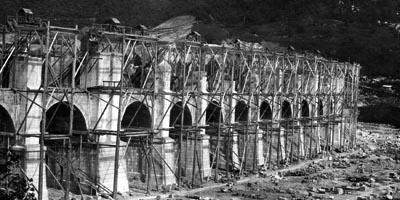
The Viaduct Construction
The Borovnica Viaduct used to be the largest bridging structure in the Southern Railway route between Vienna and Trieste…

Borovnica
At that time, Borovnica, a small village in the southern part of the Ljubljana Moors, had about fifty houses…

The life of Viaduct
The railway line over the Borovnica and other viaducts was insulated with compacted clay…
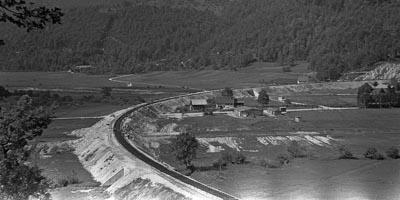
The construction of a new line
Borovnica was liberated on 6 May 1945, when it was entered by units of the 29th Herzegovina’s Strike Division…

This website is a part of the project »Thematic Park and Memorial Path of Borovnica Viaduct«, co-financed by the European Fund
for Regional Development (EFRD) throught the Local Action Group Barje z zaledjem.







